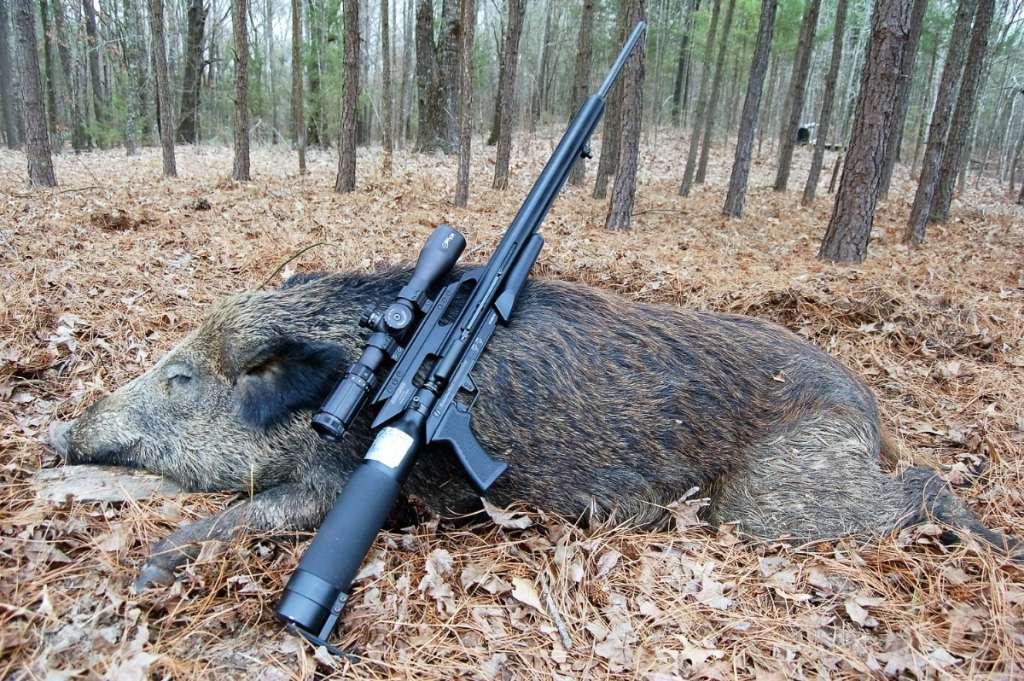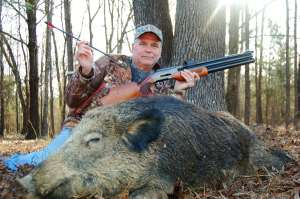In Texas, hog hunting is year-round with no seasons, no bag limits and no restrictions on the methods of harvest. Traveling hunters don’t even need a license to hunt them on private land now. But if there were a season to pick a time, it would be right after the close of the general deer season.
The weather is chilly and yes, it does get cold here in the Lone Star State. Wild porkers are fattened up from eating the hard mast crops such as acorns, pecans and hickory nuts, as well as corn supplied in large quantities by deer hunters via their corn feeders. 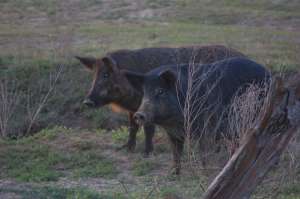
Hunters traveling to Texas to hunt hogs often come with the mindset of, “Come on down, farmers and ranchers will gladly open their gates to anyone with a rifle and desire to kill hogs.”
I’m not saying that it’s not possible to develop relationships with landowners and gain free access to good Texas hog hunting spots, but that does require a bit of time and legwork. Those are commodities that most-out-of-state hunters don’t possess during a short visit to Texas to stock their coolers.
Most farmers and ranchers have a distinct dislike for the damage feral hogs cause on their property and so aggressively attempt to keep numbers under control by trapping. Many of them, after the close of deer season, lease their land strictly for Texas hog hunting. This brings in a bit of extra cash and helps reduce the number of hogs and the destruction they cause. And then, there are the ranches that ‘love to hate hogs. While they detest the damage caused by the wild porkers, they like the added dollars that hunting them brings in.
Limited Public Land
Although public land hunting for wild hogs does exist, it is extremely limited to scheduled hunts on Wildlife Management Areas, and there also are some opportunities on national forest lands in the eastern portion of the state. Hunters coming to Texas should have a good game plan before heading south, and that plan should probably include a reputable outfitter.
Hog hunts don’t really have to be “guided,”, but they can be. Outfitters usually just drop hunters off at blinds, where they hunt over bait on their own, usually over a corn feeder or bait pile. The outfitters return at a pre-determined time to pick up the hunter and hopefully his or her hog.
Other Guided Hunts
Guided hunts can also be arranged with outfitters that hunt hogs with dogs, or who possibly specialize in night hunting with thermal scopes. Those with deep pockets might even opt for a helicopter shoot. For obvious reasons, these specialized types of hunts require an experienced guide that supplies the trained hog dogs or equipment for a thermal night hunt.
It’s a good idea to quiz your outfitter about the way you wish to hunt. Some ranches are “bow only” and allow stalking or sitting in a stand over corn feeders. Others specialize in night hunting, a time when the porkers are usually most active, using either lights around feeders or some sort of night vision. Most scopes with wide-objective lenses cranked down to the lowest power work well at night for close shots around lighted feeders.
But don’t think for a minute that you can’t kill hogs during daylight hours. Stalking is productive throughout the day, and those last 30 minutes of daylight watching a corn feeder can be magic!
Semi-Guided Hunts
The majority of hunters coming to Texas opt for one of the semi-guided hunts, where lodging, transportation to and from the hunting areas and game processing are often provided. There are plenty of ranches all over the state that provide these services, and so there is no need to do a lot of driving around from motel to hunting area.
The majority of ranches have walk-in coolers to ensure your pork is properly chilled. This can be a big plus when the weather is warm. While we do have cold days here in Texas during the winter and early spring months, where pork can be hung outside to chill, there are many days with the temperature in the 50- and 60-degree mark. Hunters driving down to hunt are advised to bring enough coolers to handle all the fresh pork they hope to take home or else make plans to donate it locally. It’s nice to be able to pack pre-chilled quarters that have been hanging in a walk-in cooler into an ice chest and head home. The alternative is keeping your pork on ice for the duration of your hunt, which can be a bit challenging.
Check on the Meat
When planning your hunt, make sure and ask your outfitter about care of the meat. Wild pork is nutritious and tasty when handled properly in the field, so make game care a priority and plan ahead.
If your desire is a long tusk boar and ultimately a shoulder mount for your game room, it might be a good idea to have a local taxidermist do the work. You may need to plan ahead for that.
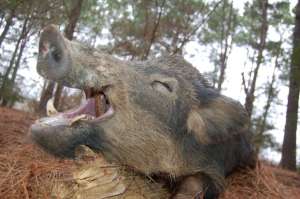
High Fence or Open Range?
I am often asked about hunting high-fenced ranches (hog proof) versus open-range conditions. This is a somewhat loaded question and there is no pat answer. But there are some factors a traveling hunter needs to consider. It’s important to know that hogs hunted inside the confines of a fence are still wild hogs, usually trapped and stocked. A trapped hog is a wild hog with the same keen sense and ability to evade man as he had outside the fence.
Some pigs are born inside the preserve, but the vast majority will be wild-tapped, thus truly wild hogs. I’ve hunted many ranches (usually in the eastern part of the state) that consist of a few hundred acres of natural cover. I can attest that the hunting was every bit as challenging as hunting open range. The big difference is that the hogs will be somewhere on the property and not five miles down the creek. This is a factor to consider if you only have a couple of days’ time to hunt.
Big Ranch Hunting
I have also hunted many big ranches in areas with heavy hog populations that provided excellent hunting. I would be careful of hunting small acreage low-fence operations. Hogs are known to move around a great deal. A 100-acre tract of land might be loaded with hogs for a while, but when the food supply dwindles, they can move out on a moment’s notice.
Wild porkers are one of the smartest critters in the woods and they often respond to hunting pressure by vacating the premises for a few days. If you’re planning on hunting a ranch with free-range hogs, inquire about the amount of land you will be hunting.
Last but not least, bring clothing that will serve your needs and pack for summer in the Caribbean to winter in North Dakota. Weather conditions change fast in Texas!
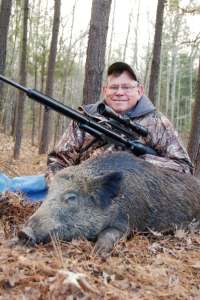
Recommended Texas Hog hunting ranches
RangerCreek Ranch is located a couple of hours west of Fort Worth in Knox County. It provides excellent Texas hog hunting for free-range hogs. Lodging, walk-in cooler and meals can be provided.
B&C Outfitters offers both preserve hunts and open-range hunts, but most hunters opt for hunting inside the game fence. Lodging and meals can be provided. Owner Mark Balette has offered hog hunts since the 1980s with the option of hunting exotics.
Curing Your Ham
A few years ago, I learned just how easy it is to cure and smoke ham from the wild hogs that I shoot. Rather than cure the entire ham, bone-in, I much prefer curing pieces of the upper part of the hindquarter and both backstraps.
I prefer using a sugar cure which I order from Butcher Packer Supply for about $6. Begin with cuts of prime pork weighing two to three pounds and rub the cure well into the meat. Then add additional dark brown sugar, place the cuts of meat in a plastic container, and allow the meat to cure in the refrigerator for 6 or 7 days.
Next, I smoke the meat for several hours at a low temperature, making sure not to dry it out. It is sometimes necessary to apply a little olive oil to the pieces of ham as they slow-smoke. Remember, this is the cold-smoking process, and you are not actually cooking the cured meat.
I use a Smokin Tex electric smoker so that I can easily keep the temperature at 150˚. If you use a wood-fired smoker, you’ll have to keep a close eye on the temperature and never let it get above 150 ˚.
Through the years, I’ve made and eaten a lot of sugar-cured ham from wild hogs I’ve harvested. It makes a great addition to a big breakfast of eggs, potatoes and biscuits!
Per our affiliate disclosure, we may earn revenue from the products available on this page. To learn more about how we test gear, click here.



